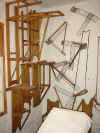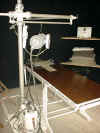The Partisan Hospital "Franja"
 The
Partisan Hospital "Franja" is without any doubt the most attractive
and most unique cultural and historical Monument in the village of Novaki
near Cerkno - but not only that: it is a unique Hospital of its kind in
whole Slovenia, and in Europe and most certainly in the World as
well. No wonder it is being nominated to be listed at The UNESCO World
Natural and Cultural Heritage Sites.
The
Partisan Hospital "Franja" is without any doubt the most attractive
and most unique cultural and historical Monument in the village of Novaki
near Cerkno - but not only that: it is a unique Hospital of its kind in
whole Slovenia, and in Europe and most certainly in the World as
well. No wonder it is being nominated to be listed at The UNESCO World
Natural and Cultural Heritage Sites.
 The
Hospital was established in December1943 and after that it had been enlarged
step by step until the end of the World War II. Its main purpose was to take
care of many wounded and ill Partisans from all Slovenia, though most of
them came from Notranjska and Gorenjska Regions. The Capacity of the
Hospital at was 108 beds for patients.
The
Hospital was established in December1943 and after that it had been enlarged
step by step until the end of the World War II. Its main purpose was to take
care of many wounded and ill Partisans from all Slovenia, though most of
them came from Notranjska and Gorenjska Regions. The Capacity of the
Hospital at was 108 beds for patients.
The
first wounded came to the Hospital on December 23. 1943. The first Doctor  in
Charge was Viktor Volčjak, while the brave and courageous Dr. Franja
Bojc took it over in February 1944. The Hospital was later on named
after her! But there are other Physicians that need to be mentioned as well:
A surgery team led by Franc Derganc had come to the hospital from time to
time to perform surgeries, and there were Dr.Vladislav Klein, Dr.Edvard
Pohar, Dr.Bogdan Brecelj, Dr.Franc Podkoritnik-Ocka and Dr.Antonio
Ciccarelli-Anton from Italy, too.
in
Charge was Viktor Volčjak, while the brave and courageous Dr. Franja
Bojc took it over in February 1944. The Hospital was later on named
after her! But there are other Physicians that need to be mentioned as well:
A surgery team led by Franc Derganc had come to the hospital from time to
time to perform surgeries, and there were Dr.Vladislav Klein, Dr.Edvard
Pohar, Dr.Bogdan Brecelj, Dr.Franc Podkoritnik-Ocka and Dr.Antonio
Ciccarelli-Anton from Italy, too.
The Hospital operated all the time - with the exception of April and May 1944 - up until the very end of World War II.
All in all over 900 patients were treated in the hospital within that period, 522 of them in the central Division, and 80 of them were members of other Nationalities: Russians, Italians. Americans, Polacks,...)
The
Hospital had been under constant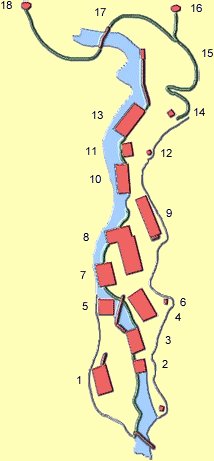 reconstruction and rebuilding as the needs
grew. At the end of WW II. it had many barracks (see picture to the right
and move cursor over it) for the wounded and ill
Partisans, for the Disabled, for Doctors and other Medical Staff, for the
operations and for the X-Ray, the cauldron for disinfections, there was a special
limb cemetery, barracks for storage, there were
workshops, bathroom, Power Plant, Laundry, special Shelters for the
emergency cases, Water reservoir, etc....
reconstruction and rebuilding as the needs
grew. At the end of WW II. it had many barracks (see picture to the right
and move cursor over it) for the wounded and ill
Partisans, for the Disabled, for Doctors and other Medical Staff, for the
operations and for the X-Ray, the cauldron for disinfections, there was a special
limb cemetery, barracks for storage, there were
workshops, bathroom, Power Plant, Laundry, special Shelters for the
emergency cases, Water reservoir, etc....
The Hospital Franja was the only one of many similar Hospitals all over Slovenia that had its own, very well and strictly organized defence and the protective measures had all the time been taken care of very rigorously. No trespass nor admittance was able without previous announcement since there were several bridges that had to be lifted to enable the way to the Hospital. The only way to get to the Hospital led across the small River of Pasica through the very deep and narrow Gorge. And there was a special battle unit prepared to defend the Hospital in case it was discovered by the enemy - what fortunately never happened, though once the Germans came very close. But the Hospital was so well covered and masked they didn't actually see it. The defence were ready to shoot, so close it was!
Hospital Franja is most visited among all the Partisan Monuments from the World War II. period in Slovenia nd is one of the best preserved Sites of the kind. It had also been granted the most wide publicity Worldwide.
The
Hospital had been revitalized and taken care of all the time after the WW
II., especially between 1989
and 1990, after the severe damage it suffered then.
 The
Franja Partisan Hospital, named after the physician Dr. Franja Bojc Bidovec,
operated in the period from 1943-45 in Dolenje Novake near Cerkno. To this
day, this legendary hospital has preserved its authentic appearance and
represents a symbol of the partisan medical service. It remains an
exceptional testimony of the humanity and resourcefulness of partisan
physicians and other medical staff in the preservation of human lives.
The
Franja Partisan Hospital, named after the physician Dr. Franja Bojc Bidovec,
operated in the period from 1943-45 in Dolenje Novake near Cerkno. To this
day, this legendary hospital has preserved its authentic appearance and
represents a symbol of the partisan medical service. It remains an
exceptional testimony of the humanity and resourcefulness of partisan
physicians and other medical staff in the preservation of human lives.
The
Slovene military partisan hospital Franja (SVPB Franja), also named
"Department B", was established as a central hospital facility
for treating severely wounded and ill persons. Several smaller units were
scattered 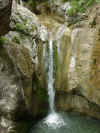 throughout the nearby and broader surroundings. Altogether some
1000 patients were treated in all the departments. As many as 522 wounded
soldiers of various nationalities were treated in Department B alone. 61
soldiers died during the course of treatment and were buried in a secret
place just above the present-day path leading to the hospital. For easier
identification, a small bottle containing a piece of paper with the
deceased personal data was placed in graves alongside the dead.
throughout the nearby and broader surroundings. Altogether some
1000 patients were treated in all the departments. As many as 522 wounded
soldiers of various nationalities were treated in Department B alone. 61
soldiers died during the course of treatment and were buried in a secret
place just above the present-day path leading to the hospital. For easier
identification, a small bottle containing a piece of paper with the
deceased personal data was placed in graves alongside the dead.
The hospital's existence and operation depended on at least two factors. One was preserving the secrecy of its location, which called for the strict observation of all safety measures. The other was the faithful and reliable assistance of local inhabitants.
The wounded were admitted at a checkpoint near Pasice village and blindfolded before being carried into the gorge. For safety reasons, access to the huts was along the streambed, and defence fortifications and hidden shelters for the wounded were built on steep rocky slopes.
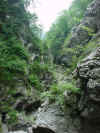 Despite
the very difficult conditions and the frequent need to perform very
demanding surgical operations, the treatment of wounded persons was
successful in most cases. Medicines and sanitary supplies were collected
by field organizations and occasionally sent by western Allies. Various
orthopaedic accessories were made in the hospital's own workshops. A
unique method was developed for sterilizing instruments and dressings.
Despite
the very difficult conditions and the frequent need to perform very
demanding surgical operations, the treatment of wounded persons was
successful in most cases. Medicines and sanitary supplies were collected
by field organizations and occasionally sent by western Allies. Various
orthopaedic accessories were made in the hospital's own workshops. A
unique method was developed for sterilizing instruments and dressings.
The supply of other necessities of life was well organized and the hospital patients never experienced hunger. They were even offered entertainment, fresh news and cultural events. From May 1944 onwards they issued their own bulletin, entitled "Bolniski list" (Patient's Bulletin).
In the final phase, the central hospital department in the Pasica gorge had as many as 11 cabins, including an X-ray cabin and a power plant. In the decades following the Second World War, the Franja Partisan Hospital continued to arouse interest. Visitors came from all continents. The responsibility for its maintenance and restoration was assumed by the Idrija Municipal Museum. Considerable efforts and funds were needed to preserve the hospital in its authentic form throughout the post-war years, particularly for its restoration after the disastrous accident that occurred in January 1989. An enormous avalanche thundered into the gorge from the slopes of Veliki Njivec, causing absolute devastation. The access route to the hospital was buried and the first three cabins demolished and many others damaged.
The
mass of rock dammed the Cerinscica stream, threatening to flood the cabins
and their contents in the event of prolonged rainfall. All the contents of
the cabins were evacuated and moved to the Museum department in Cerkno.
This was followed by the removal of rocks and the reconstruction of
cabins. The hospital was reopened to the public on 10 June, 1990. Thanks
to the enormous endeavours of the Museum personnel and the  contributions
of many individuals, societies and organizations from all parts of
Slovenia, neighbouring countries and abroad, this unique cultural monument
has been preserved as a remembrance and a reminder to present and future
generations.
contributions
of many individuals, societies and organizations from all parts of
Slovenia, neighbouring countries and abroad, this unique cultural monument
has been preserved as a remembrance and a reminder to present and future
generations.
In 1997 the hospital received an acknowledgement from the American Association of Pilots Saved during the War in recognition of its assistance to American pilot Harold Adams. (Source: Carmina Historica).




